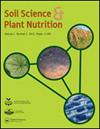水培条件下日本山葵(Eutrema japonicum)生长的营养特性及离子特征
IF 1.8
4区 农林科学
Q3 ENVIRONMENTAL SCIENCES
引用次数: 0
摘要
摘要日本山葵传统上是在有流动水流条件的梯田中种植的,这通常会产生高质量的产量。以前的研究已经探索了在这种条件下水营养状况的一些影响;然而,这些栽培条件下水分营养状况与山葵生长和品质之间的关系仍是完全未知的。我们评估了营养强度、无机氮源和培养基pH对山葵植物生长的影响。然后,我们分析了两个主要的日本山葵品种(“Onimidori”,早期生长的绿茎型;以及在一系列pH条件下生长的“Mazuma 1号”(一种晚熟的红茎型)。这些实验是用水培系统进行的。在NH4-N:NO3-N比例为50:50的1/10和1/2强度的Hoagland溶液中,山葵的茎和根生长最好。从NO3−、氨基酸和叶绿素的积累规律来看,1/10浓度的营养液为山葵生长提供了最优条件。两种山葵品种的茎、根生长均以pH为6.0的培养基为最佳。“鬼imidori”的光合能力大于“Mazuma 1号”,这可能是“鬼imidori”生长更快的原因。离子组分析揭示了组织特异性矿物质积累模式及其在不同pH条件下和两个品种之间的差异。基于离子组的多元回归分析揭示了山葵植株中元素浓度分布,尤其是根部元素浓度分布与植株生长之间的关系。山葵植物是氨敏感和硝酸盐偏好的植物,除了相对较低的营养需求,以达到最佳生长。本研究结果描述了山葵植物的基本营养特性。这些发现为在传统淹水栽培系统中优化施肥控制山葵品质和生长迈出了重要的一步。我们感谢Edanz (https://jp.edanz.com/ac)的Jennifer Smith博士编辑了本文的草稿。披露声明作者未报告潜在的利益冲突。本研究得到栗田水与环境基金会(编号19B001 (T.I.))和浦上食品与饮食文化促进基金会(T.I.)的支持。本文章由计算机程序翻译,如有差异,请以英文原文为准。
Nutritional characterization on growth and ionome profiles in Japanese wasabi cultivars ( Eutrema japonicum ) under hydroponics
ABSTRACTJapanese wasabi is traditionally cultivated in terraced fields with running stream water conditions which typically produce a high-quality of yield. Previous studies have explored some of the effects of water nutrient status under such conditions; however, the relationship between water nutrient status in these cultivation conditions and the growth and quality of wasabi is still completely unknown. We evaluated the effects of nutrient strength, inorganic nitrogen sources, and pH of the medium on the growth of wasabi plants. Then, we analyzed the photosynthetic capacity and the ionomes of two major Japanese wasabi cultivars (‘Onimidori,’ an early-growing green-stem type; and ‘Mazuma No.1,’ a late-growing red-stem type) grown under a range of pH conditions. These experiments were conducted using a hydroponic system. Wasabi plants showed the best shoot and root growth in 1/10- and 1/2-strength Hoagland’s solution with a 50:50 ratio of NH4-N:NO3-N. On the basis of the accumulation patterns of NO3−, amino acids, and chlorophylls, the 1/10-strength nutrient solution provided optimal conditions for wasabi growth. For both wasabi cultivars, the best shoot and root growth was in medium at pH 6.0. The photosynthetic capacity of ‘Onimidori’ was greater than that of ‘Mazuma No.1,’ suggesting that this may contribute to the faster growth of ‘Onimidori.’ Ionome analyses revealed tissue-specific mineral accumulation patterns and their differences among different pH conditions and between the two cultivars. Ionome-based multiple-regression analysis revealed a relationship between element concentration profiles in the wasabi plants, especially those in root, and the shoot growth. Wasabi plants are ammonium-sensitive and nitrate-preferring plants, in addition to relatively low nutrient requirements for optimal growth. The results of this study describe the basic nutritional characteristics of wasabi plants. These findings represent an important step toward optimizing fertilization to control wasabi quality and growth in the traditional flooded cultivation system.KEY WORDS: Ionomenitrogenphphotosynthesiswasabi AcknowledgmentsWe thank Jennifer Smith, PhD, from Edanz (https://jp.edanz.com/ac) for editing a draft of this manuscript.Disclosure statementNo potential conflict of interest was reported by the author(s).Supplementary materialSupplemental data for this article can be accessed online at https://doi.org/10.1080/00380768.2023.2276716Additional informationFundingThis work was supported by Kurita Water and Environment Foundation, number 19B001 (T.I.) and Urakami Foundation for Food and Food Culture Promotion (T.I.).
求助全文
通过发布文献求助,成功后即可免费获取论文全文。
去求助
来源期刊

Soil Science and Plant Nutrition
农林科学-农艺学
CiteScore
4.80
自引率
15.00%
发文量
56
审稿时长
18-36 weeks
期刊介绍:
Soil Science and Plant Nutrition is the official English journal of the Japanese Society of Soil Science and Plant Nutrition (JSSSPN), and publishes original research and reviews in soil physics, chemistry and mineralogy; soil biology; plant nutrition; soil genesis, classification and survey; soil fertility; fertilizers and soil amendments; environment; socio cultural soil science. The Journal publishes full length papers, short papers, and reviews.
 求助内容:
求助内容: 应助结果提醒方式:
应助结果提醒方式:


